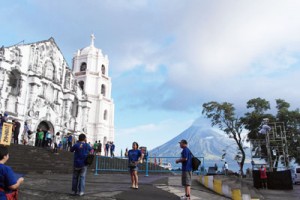THE restoration of churches damaged by the earthquake last year in provinces of Bohol and Cebu will take years because of the enormous amount of work needed to rebuild them.
The National Commission for Culture and the Arts (NCCA) said experts are still assessing the damage sustained by heritage churches, seven months after the massive temblor.
“A Spanish delegation was sent to assess the damage,” said Dr. Stephen Totanes, vice head of the Subcommision on Cultural Heritage (SCH) and head of the NCCA’s National Committee on Historical Research. He said experts are also still evaluation the costs.
When asked if the churches can be restored to their former grandeur, Totanes said the work will depend on the architects’ technical assessment of the ruins.
“It will be a slow procedure,” he admitted. “Some of the old walls cannot be restored and must be rebuilt.”
The NCCA is also occupied in the preservation of old churches in Almasor (Albay, Masbate, Sorsogon). Although these churches were spared from heavy damage from natural calamities, they face danger from human hands, according to Totanes.
“Our concern in Bicol is some renovations being done by parish priests working independently of national agencies,” Totanes said. For example, he said, a church was painted in new colors.
“No major disaster has happened since I took office and most of the vulnerable structures were already damaged so we allotted funds for them,” Albay Gov. Joey Salceda said.
Salceda said the sites undergoing restoration included the ruins in Colegio de San Buenaventura in Guinobatan—the biggest college outside Manila—a convent, the church in Bacacay and 11 colonial houses in Camalig.
Totanes said they will get international experts, preferably from Spain, because the old church designs were Spanish-influenced.
“The bigger problem is the material needed. They used materials which may not be readily available like lime, limestone. We cannot just put whatever material in,” he said.
Salceda said the local government allots funds for the preservation and restoration of old churches but the NCCA also help raise funds from local and international donors because cost of cannot be shouldered alone by local government units.
But preservation is not enough.
“We should practice culture so that it would be part of our muscle memory. The creation of handicrafts here is like that,” Salceda said, noting that culture is something that cannot be taken away from them.
He attributed the globally praised resiliency of Filipinos to art.
“Our cultural assets are immune to disasters,” Salceda said, “and they are the basis of our hope. Culture in this sense becomes a way of becoming source of resiliency.”
Mayor Noel Rosal of Legazpi City agreed. “Our cultural heritage is a source of strength in times of adversity. It will no doubt contribute in shaping our future national identity,” Rosal said.
No sense of continuity
Totanes however lamented that there is no sense of “continuity”, thus the need to drum up support and cooperation from local communities.
“The stakeholders don’t have a sense of continuity from the past. What your grandparents went through, you pass it on to your children,” Totanes pointed out.
The commission and local governments and dioceses in Almasor on Saturday signed a memorandum of understanding for cooperation and collaboration in protecting heritage sites and possible new ones.
“We would like to encourage the parishes to preserve the historical features of the old churches. If we want to make a new design we can always build another structure. Let’s not tamper with the old, because it’s already part of our history,” heritage advocate Ivan Henares said,
Declared national treasures are protected under the Heritage Law.
Henares noted that sometimes, priests who are reshuffled every once in a while want to leave their mark and so make some modifications in their churches.
“We take pride in these beautiful churches. If he wants to leave his mark, a parish priest can restore the old church properly,” he said.
“Preserving the church is also preserving the memories and also strengthening their [parishioners] faith, if the church is lost to them it’s as if you lose connection with your faith,” said Fr. Harold Rentoria, OSA, head of the SCH.
The baroque Daraga Church was declared a National Cultural Treasure, at least its baptistry and its whole facade and the belfry where saints were carefully carved in volcanic ash.
The center of faith of the town was once in Cagsawa, but it was moved to Daraga when Mayon erupted.
Rentoria said the church serves as a unifying force for the people.
“Many of them (parishioners) were baptized in the church, it’s a symbol of their faith, this was where their parents were also wed, so it’s very important to them and also . . . for sure their lolo, lola would have been part of the construction,” he said.
“And the people run to the church for sanctuary in times of calamity,” Rentoria added, noting what happened in Bohol where life seemed incomplete with the churches destroyed by the quake.
Rentoria said that the challenge is to make the youth aware and to make them concerned about their heritage.
Henares said residents should act as stewards of heritage sites and monitor damages, because otherwise they stand to lose part of their history.
But the greater challenge, Rentoria said, was to unite stakeholders so that creeping urbanization will not affect the vista of heritage churches.


